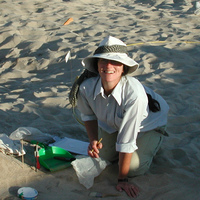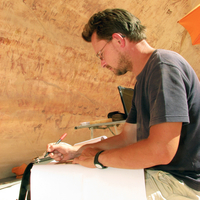
Nancy R Thomas
Phone: +1 904-710-9528
Address: Department of Humanities
Jacksonville University
2800 University Blvd. N
Jacksonville, Florida 32211 USA
Address: Department of Humanities
Jacksonville University
2800 University Blvd. N
Jacksonville, Florida 32211 USA
less
Related Authors
Wim Van Neer
Royal Belgian Institute of Natural Sciences
Renee Friedman
University of Oxford
Veerle Linseele
KU Leuven
Frank Förster
Rheinische Friedrich-Wilhelms-Universität Bonn
Henriette Baron
Leibniz-Zentrum für Archäologie
Bea De Cupere
Royal Belgian Institute of Natural Sciences
Gerhard Forstenpointner
University of Veterinary Medicine Vienna
Paul Koch
University of California, Santa Cruz
Alfred Galik
Austrian Academy of Sciences
Walter Gauss
Austrian Academy of Sciences
InterestsView All (25)








Uploads
Papers by Nancy R Thomas
AEGAEUM 45 Annales liégeoises et PASPiennes d'archéologie égéenne ZOIA ANIMAL-HUMAN INTERACTIONS IN THE AEGEAN MIDDLE AND LATE BRONZE AGE
sites in Greece and Southeastern Europe, establishing that the large-maned lion roamed freely during
the Chalcolithic and Bronze Ages and even into the Archaic period in Greece and the Balkan
peninsula. This osteological evidence has not yet been integrated into Mycenaean studies. My
paper explores specific ways in which real lion bones do, and do not, overturn our previous
understandings of the relationship of people and predators, and of nature and convention, in
Mycenaean art.
Lion bones not only illustrate instances of people/predator interaction, they also offer
new options for explaining what the bones themselves mean. For example, at Durankulak in
Bulgaria, excavators found a Neolithic family of three lions—a youth and two adults—one of
whom, according to the publisher, was “plus grand, mâle probablement.” The crania and
claws of all three of these animals were missing, suggesting that the lions were probably killed,
skinned, and butchered at the hunting site and that their heads and claws were taken back to
the village as trophies. This find demonstrates that, contrary to past opinion, teeth and claws
could indicate the presence of local, wild lions, rather than simply being the residue of
imported pelts or amulets, as was said about the first lion bone found at LH Tiryns. As
archaeologists continue to turn their attention to hunting sites as well as to habitations and
graves, more evidence will accrue on the relationships of people and predators.
Real lion bones also force us to reassess the impact of nature on convention in
Mycenaean art. For the first time we can now ask: how many of the scenarios and encounters
depicted in Mycenaean art could actually have been experienced by a lion? Apparently
Mycenaeans could have trussed a lion, butchered it, and carved a seal depicting the ritual.
Were wild lion cubs captured and tamed to serve a priestess and then depicted in an orientalizing,
heraldic format? Did real lions battle Mycenaean elites as the men tested—and illustrated—
their mettle? As a corrective to overly optimistic answers, we must also remember that griffins
were depicted in many of these same scenarios, as were leopards, though as yet no leopard (or
griffin) bones have been found in Bronze Age Greece. Furthermore, Mycenaean art presents
many unreal images of lions, such as male lions with teats nursing their young. What should
we conclude when wild nature was available but not used?
A lion’s eye view of Bronze Age Greece provides a lens for recognizing the ways in
which wild nature could have impacted Mycenaean social and religious experience as
expressed in Mycenaean art. The art itself demonstrates that, with rare exception, convention,
not wild nature, triumphed in Mycenaean imagery. This paper investigates the implications of
these contrasting outcomes. Lion bones give us real vignettes of the interactions of people and
predators in Mycenaean Greece. Bones and imagery together affirm, and contradict, our
earlier explanations of the imprint of natural lions on conventional lion art. A catalogue of lion bones found in Greece and Southeastern Europe accompanies this article.
of civilization at the beginning of its rise to power. By looking at the fundamental unit of production—the artisan with tool and material in his hands—and by following the tell-tale marks of an experienced craftsman as he tries a new medium, I suggest that two different people, both Aegeans, produced the three most sophisticated black-inlaid weapons found in the Shaft Graves at LH I Mycenae. Both artisans had extensive prior experience in other materials common in
the Aegean workshop before attempting black-metal inlay. Highly magnified photographs of the daggers indicate that both artisans had previously worked in metal and ivory, and that one of them, the maker of the Lion Hunt and Nilotic daggers, had been a painter of frescoes. Thus, the evidence of cross-craft shows that the artisans changed media after they were established craftsmen. In the case of the inlaid daggers from Mycenae, we glimpse these processes because of a
most unusual circumstance: a craftsman with a clearly visible and strongly individual artistic temperament, rare in the Aegean, moved from painting on walls to painting in metals.
AEGAEUM 45 Annales liégeoises et PASPiennes d'archéologie égéenne ZOIA ANIMAL-HUMAN INTERACTIONS IN THE AEGEAN MIDDLE AND LATE BRONZE AGE
sites in Greece and Southeastern Europe, establishing that the large-maned lion roamed freely during
the Chalcolithic and Bronze Ages and even into the Archaic period in Greece and the Balkan
peninsula. This osteological evidence has not yet been integrated into Mycenaean studies. My
paper explores specific ways in which real lion bones do, and do not, overturn our previous
understandings of the relationship of people and predators, and of nature and convention, in
Mycenaean art.
Lion bones not only illustrate instances of people/predator interaction, they also offer
new options for explaining what the bones themselves mean. For example, at Durankulak in
Bulgaria, excavators found a Neolithic family of three lions—a youth and two adults—one of
whom, according to the publisher, was “plus grand, mâle probablement.” The crania and
claws of all three of these animals were missing, suggesting that the lions were probably killed,
skinned, and butchered at the hunting site and that their heads and claws were taken back to
the village as trophies. This find demonstrates that, contrary to past opinion, teeth and claws
could indicate the presence of local, wild lions, rather than simply being the residue of
imported pelts or amulets, as was said about the first lion bone found at LH Tiryns. As
archaeologists continue to turn their attention to hunting sites as well as to habitations and
graves, more evidence will accrue on the relationships of people and predators.
Real lion bones also force us to reassess the impact of nature on convention in
Mycenaean art. For the first time we can now ask: how many of the scenarios and encounters
depicted in Mycenaean art could actually have been experienced by a lion? Apparently
Mycenaeans could have trussed a lion, butchered it, and carved a seal depicting the ritual.
Were wild lion cubs captured and tamed to serve a priestess and then depicted in an orientalizing,
heraldic format? Did real lions battle Mycenaean elites as the men tested—and illustrated—
their mettle? As a corrective to overly optimistic answers, we must also remember that griffins
were depicted in many of these same scenarios, as were leopards, though as yet no leopard (or
griffin) bones have been found in Bronze Age Greece. Furthermore, Mycenaean art presents
many unreal images of lions, such as male lions with teats nursing their young. What should
we conclude when wild nature was available but not used?
A lion’s eye view of Bronze Age Greece provides a lens for recognizing the ways in
which wild nature could have impacted Mycenaean social and religious experience as
expressed in Mycenaean art. The art itself demonstrates that, with rare exception, convention,
not wild nature, triumphed in Mycenaean imagery. This paper investigates the implications of
these contrasting outcomes. Lion bones give us real vignettes of the interactions of people and
predators in Mycenaean Greece. Bones and imagery together affirm, and contradict, our
earlier explanations of the imprint of natural lions on conventional lion art. A catalogue of lion bones found in Greece and Southeastern Europe accompanies this article.
of civilization at the beginning of its rise to power. By looking at the fundamental unit of production—the artisan with tool and material in his hands—and by following the tell-tale marks of an experienced craftsman as he tries a new medium, I suggest that two different people, both Aegeans, produced the three most sophisticated black-inlaid weapons found in the Shaft Graves at LH I Mycenae. Both artisans had extensive prior experience in other materials common in
the Aegean workshop before attempting black-metal inlay. Highly magnified photographs of the daggers indicate that both artisans had previously worked in metal and ivory, and that one of them, the maker of the Lion Hunt and Nilotic daggers, had been a painter of frescoes. Thus, the evidence of cross-craft shows that the artisans changed media after they were established craftsmen. In the case of the inlaid daggers from Mycenae, we glimpse these processes because of a
most unusual circumstance: a craftsman with a clearly visible and strongly individual artistic temperament, rare in the Aegean, moved from painting on walls to painting in metals.